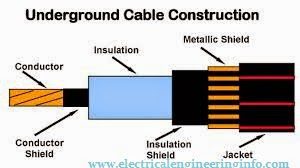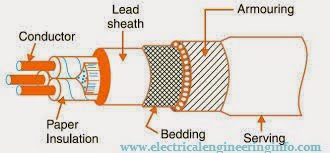Construction of Underground cables:
Hello Mr./Mrs. visitor .First of all thanks for visiting my site.Here I am going you to explain the Construction of Underground cables.Topics like what type of material is used , where they are laid ,what are the protective measures etc..Lets us start now.An underground cable essentially consists of one or more conductors covered with suitable insulation and surrounded by a protecting cover.Although several types of underground cables are available, the type of cable to be used will depend upon the working voltage and service requirements. In general, a cable must fulfil the following necessary requirements :
(i) The conductor used in underground cables should be tinned stranded copper or aluminium of high conductivity. Stranding is done so that conductor may become flexible and carry more current.
(ii) The conductor size should be such that the cable carries the desired load current without overheating and causes voltage drop within permissible limits.
(iii) The cable must have proper thickness of insulation in order to give high degree of safety and reliability at the voltage for which it is designed.
(iv) The cable must be provided with suitable mechanical protection so that it may withstand the rough use in laying it.
(v) The materials used in the manufacture of underground cables should be such that there is complete chemical and physical stability throughout.
 |
| Underground Cable Construction |
Construction of Underground cables:
(i) Cores or Conductors : A cable may have one or more than one core (conductor) depending upon the type of service for which it is intended. For instance, the 3-conductor cable shown in figure below is used for 3-phase service.The conductors are made of tinned copper or aluminium and are usually stranded in order to provide flexibility to the underground cable.
(ii) Insulatian : Each core or conductor is provided with a suitable thickness of insulation, the thickness of layer depending upon the voltage to be withstood by the cable. The commonly used materials for insulation are impregnated paper, varnished cambric or rubber mineral compound.
(iii) Metallic sheath : In order to protect the underground cables from moisture,gases or other damaging liquids (acids or alkalies) in the soil and atmosphere, a metallic sheath of lead or aluminium is provided over the insulation as shown in Figure below.
(iv) Bedding : Over the metallic sheath is applied a layer of bedding which consists of a fibrous material like jute or hessian tape. The purpose of bedding is to protect the metallic sheath against corrosion and from mechanical injury due to armouring.
(v) Armouring : Over the bedding, armouring is provided which consists of one or two layers of galvanised steel wire or steel tape.Its purpose is to protect the cable from mechanical injury while laying it and during the course of handling. Armouring may not be done in the case of some underground cables.
(vi) Serving : In order to protect armouring from atmospheric conditions, a layer of fibrous material (like jute) similar to bedding is provided over the armouring. This is known as serving.

- In this you have learnt about how the underground cables are constructed and what are the materials used in underground cables.